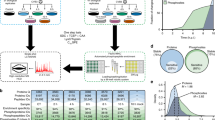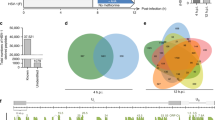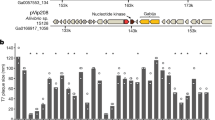Abstract
Protein kinase PKR (also known as EIF2AK2) is activated during viral infection and phosphorylates the α subunit of eukaryotic translation initiation factor 2 (eIF2), leading to inhibition of translation and viral replication. We report fast evolution of the PKR kinase domain in vertebrates, coupled with positive selection of specific sites. Substitution of positively selected residues in human PKR with residues found in related species altered sensitivity to PKR inhibitors from different poxviruses. Species-specific differences in sensitivity to poxviral pseudosubstrate inhibitors were identified between human and mouse PKR, and these differences were traced to positively selected residues near the eIF2α binding site. Our findings indicate how an antiviral protein evolved to evade viral inhibition while maintaining its primary function. Moreover, the identified species-specific differences in the susceptibility to viral inhibitors have important implications for studying human infections in nonhuman model systems.
This is a preview of subscription content, access via your institution
Access options
Subscribe to this journal
Receive 12 print issues and online access
$189.00 per year
only $15.75 per issue
Buy this article
- Purchase on Springer Link
- Instant access to full article PDF
Prices may be subject to local taxes which are calculated during checkout





Similar content being viewed by others
References
Pichlmair, A. & Reis e Sousa, C. Innate recognition of viruses. Immunity 27, 370–383 (2007).
Ishii, K.J. & Akira, S. Innate immune recognition of nucleic acids: beyond toll-like receptors. Int. J. Cancer 117, 517–523 (2005).
Kaufman, R.J. Double-stranded RNA-activated protein kinase PKR. in Translational Control of Gene Expression (eds. Sonenberg, N., Hershey, J.W.B. & Mathews, M.B.) 503–527 (Cold Spring Harbor Laboratory Press, Cold Spring Harbor, NY, 2000).
Dey, M. et al. Mechanistic link between PKR dimerization, autophosphorylation, and eIF2α substrate recognition. Cell 122, 901–913 (2005).
Barber, G.N. The dsRNA-dependent protein kinase, PKR and cell death. Cell Death Differ. 12, 563–570 (2005).
Dever, T.E., Dar, A.C. & Sicheri, F. The eIF2α Kinases. in Translational Control in Biology and Medicine (eds. Mathews, M.B., Sonenberg, N. & Hershey, J.W.) 319–344 (Cold Spring Harbor Laboratory Press, Cold Spring Harbor, NY, 2007).
Dever, T.E. Gene-specific regulation by general translation factors. Cell 108, 545–556 (2002).
Toth, A.M., Zhang, P., Das, S., George, C.X. & Samuel, C.E. Interferon action and the double-stranded RNA-dependent enzymes ADAR1 adenosine deaminase and PKR protein kinase. Prog. Nucleic Acid Res. Mol. Biol. 81, 369–434 (2006).
Langland, J.O., Cameron, J.M., Heck, M.C., Jancovich, J.K. & Jacobs, B.L. Inhibition of PKR by RNA and DNA viruses. Virus Res. 119, 100–110 (2006).
Beattie, E., Tartaglia, J. & Paoletti, E. Vaccinia virus-encoded eIF-2α homolog abrogates the antiviral effect of interferon. Virology 183, 419–422 (1991).
Davies, M.V., Elroy-Stein, O., Jagus, R., Moss, B. & Kaufman, R.J. The vaccinia virus K3L gene product potentiates translation by inhibiting double-stranded-RNA-activated protein kinase and phosphorylation of the α subunit of eukaryotic initiation factor 2. J. Virol. 66, 1943–1950 (1992).
Carroll, K., Elroy-Stein, O., Moss, B. & Jagus, R. Recombinant vaccinia virus K3L gene product prevents activation of double-stranded RNA-dependent, initiation factor 2α-specific protein kinase. J. Biol. Chem. 268, 12837–12842 (1993).
Kawagishi-Kobayashi, M., Silverman, J.B., Ung, T.L. & Dever, T.E. Regulation of the protein kinase PKR by the vaccinia virus pseudosubstrate inhibitor K3L is dependent on residues conserved between the K3L protein and the PKR substrate eIF2α. Mol. Cell. Biol. 17, 4146–4158 (1997).
Dar, A.C. & Sicheri, F. X-ray crystal structure and functional analysis of vaccinia virus K3L reveals molecular determinants for PKR subversion and substrate recognition. Mol. Cell 10, 295–305 (2002).
Ramelot, T.A. et al. Myxoma virus immunomodulatory protein M156R is a structural mimic of eukaryotic translation initiation factor eIF2α. J. Mol. Biol. 322, 943–954 (2002).
Dhaliwal, S. & Hoffman, D.W. The crystal structure of the N-terminal region of the α subunit of translation initiation factor 2 (eIF2α) from Saccharomyces cerevisiae provides a view of the loop containing serine 51, the target of the eIF2α-specific kinases. J. Mol. Biol. 334, 187–195 (2003).
Nonato, M.C., Widom, J. & Clardy, J. Crystal structure of the N-terminal segment of human eukaryotic translation initiation factor 2α. J. Biol. Chem. 277, 17057–17061 (2002).
Kawagishi-Kobayashi, M., Cao, C., Lu, J., Ozato, K. & Dever, T.E. Pseudosubstrate inhibition of protein kinase PKR by swine pox virus C8L gene product. Virology 276, 424–434 (2000).
Chang, H.W., Watson, J.C. & Jacobs, B.L. The E3L gene of vaccinia virus encodes an inhibitor of the interferon-induced, double-stranded RNA-dependent protein kinase. Proc. Natl. Acad. Sci. USA 89, 4825–4829 (1992).
Romano, P.R. et al. Inhibition of double-stranded RNA-dependent protein kinase PKR by vaccinia virus E3: role of complex formation and the E3 N-terminal domain. Mol. Cell. Biol. 18, 7304–7316 (1998).
Sharp, T.V. et al. The vaccinia virus E3L gene product interacts with both the regulatory and the substrate binding regions of PKR: implications for PKR autoregulation. Virology 250, 302–315 (1998).
Langland, J.O. & Jacobs, B.L. The role of the PKR-inhibitory genes, E3L and K3L, in determining vaccinia virus host range. Virology 299, 133–141 (2002).
Dar, A.C., Dever, T.E. & Sicheri, F. Higher-order substrate recognition of eIF2α by the RNA-dependent protein kinase PKR. Cell 122, 887–900 (2005).
Rothenburg, S. et al. A PKR-like eukaryotic initiation factor 2α kinase from zebrafish contains Z-DNA binding domains instead of dsRNA binding domains. Proc. Natl. Acad. Sci. USA 102, 1602–1607 (2005).
Rothenburg, S., Deigendesch, N., Dey, M., Dever, T.E. & Tazi, L. Double-stranded RNA-activated protein kinase PKR of fishes and amphibians: varying number of double-stranded RNA binding domains and lineage-specific duplications. BMC Biol. 6, 12 (2008).
Chong, K.L. et al. Human p68 kinase exhibits growth suppression in yeast and homology to the translational regulator GCN2. EMBO J. 11, 1553–1562 (1992).
Dever, T.E. et al. Mammalian eukaryotic initiation factor 2α kinases functionally substitute for GCN2 protein kinase in the GCN4 translational control mechanism of yeast. Proc. Natl. Acad. Sci. USA 90, 4616–4620 (1993).
Romano, P.R., Green, S.R., Barber, G.N., Mathews, M.B. & Hinnebusch, A.G. Structural requirements for double-stranded RNA binding, dimerization, and activation of the human eIF-2α kinase DAI in Saccharomyces cerevisiae. Mol. Cell. Biol. 15, 365–378 (1995).
Zhang, P. & Samuel, C.E. Protein kinase PKR plays a stimulus- and virus-dependent role in apoptotic death and virus multiplication in human cells. J. Virol. 81, 8192–8200 (2007).
Barber, G.N. et al. Translational regulation by the interferon-induced double-stranded-RNA-activated 68-kDa protein kinase. Proc. Natl. Acad. Sci. USA 90, 4621–4625 (1993).
Seo, E.J. et al. Protein kinase PKR mutants resistant to the poxvirus pseudosubstrate K3L protein. Proc. Natl. Acad. Sci. USA 105, 16894–16899 (2008).
McFadden, G. Poxvirus tropism. Nat. Rev. Microbiol. 3, 201–213 (2005).
Werden, S.J., Rahman, M.M. & McFadden, G. Poxvirus host range genes. Adv. Virus Res. 71, 135–171 (2008).
Lewis-Jones, S. Zoonotic poxvirus infections in humans. Curr. Opin. Infect. Dis. 17, 81–89 (2004).
Essbauer, S., Bremont, M. & Ahne, W. Comparison of the eIF-2α homologous proteins of seven ranaviruses (Iridoviridae). Virus Genes 23, 347–359 (2001).
Majji, S. et al. Rana catesbeiana virus Z (RCV-Z): a novel pathogenic ranavirus. Dis. Aquat. Organ. 73, 1–11 (2006).
Katoh, K., Kuma, K., Toh, H. & Miyata, T. MAFFT version 5: improvement in accuracy of multiple sequence alignment. Nucleic Acids Res. 33, 511–518 (2005).
Castresana, J. Selection of conserved blocks from multiple alignments for their use in phylogenetic analysis. Mol. Biol. Evol. 17, 540–552 (2000).
Guindon, S. & Gascuel, O. A simple, fast, and accurate algorithm to estimate large phylogenies by maximum likelihood. Syst. Biol. 52, 696–704 (2003).
Yang, Z. PAML: a program package for phylogenetic analysis by maximum likelihood. Comput. Appl. Biosci. 13, 555–556 (1997).
Pond, S.L., Frost, S.D. & Muse, S.V. HyPhy: hypothesis testing using phylogenies. Bioinformatics 21, 676–679 (2005).
Berglund, A.C., Wallner, B., Elofsson, A. & Liberles, D.A. Tertiary windowing to detect positive diversifying selection. J. Mol. Evol. 60, 499–504 (2005).
Woolley, S., Johnson, J., Smith, M.J., Crandall, K.A. & McClellan, D.A. TreeSAAP: selection on amino acid properties using phylogenetic trees. Bioinformatics 19, 671–672 (2003).
Yang, Z. Phylogenetic analysis using parsimony and likelihood methods. J. Mol. Evol. 42, 294–307 (1996).
Cesareni, G. & Murray, J.A.H. Plasmid vectors carrying the replication origin of filamentous single-stranded phages. in Genetic Engineering: Principals and Methods, Vol. 9 (eds. Setlow, J.K. & Hollaender, A.) 135–154 (Plenum Press, New York, NY, 1987).
Dever, T.E. et al. Phosphorylation of initiation factor 2α by protein kinase GCN2 mediates gene-specific translational control of GCN4 in yeast. Cell 68, 585–596 (1992).
Acknowledgements
We are grateful to A. Hinnebusch, M. Yu and L. Tazi for helpful discussion and for careful reading of the manuscript; F. Sicheri, M. Dey, D. McClellan, A. Furano and C. Tellgren-Roth for helpful discussion; C. Samuel (University of California, Santa Barbara) for providing the PKR knockdown cells; and M. Kawagishi-Kobayashi and M. Dey (US National Institute of Child Health and Human Development (NICHD)) for yeast strains. This work was supported by funding from the Intramural Research Program of the US National Institutes of Health, NICHD, to T.E.D.
Author information
Authors and Affiliations
Corresponding author
Supplementary information
Supplementary Text and Figures
Supplementary Figures 1–6 and Supplementary Tables 1–6 (PDF 2105 kb)
Rights and permissions
About this article
Cite this article
Rothenburg, S., Seo, E., Gibbs, J. et al. Rapid evolution of protein kinase PKR alters sensitivity to viral inhibitors. Nat Struct Mol Biol 16, 63–70 (2009). https://doi.org/10.1038/nsmb.1529
Received:
Accepted:
Published:
Issue Date:
DOI: https://doi.org/10.1038/nsmb.1529
This article is cited by
-
What Do We Know About the Smallpox Virus? A Journey Between Clinic and Therapy
Pharmaceutical Research (2023)
-
Design and synthesis of novel protein kinase R (PKR) inhibitors
Molecular Diversity (2016)
-
Mechanisms of viral mutation
Cellular and Molecular Life Sciences (2016)
-
Reduced protein synthesis in schizophrenia patient-derived olfactory cells
Translational Psychiatry (2015)
-
The duck genome and transcriptome provide insight into an avian influenza virus reservoir species
Nature Genetics (2013)



